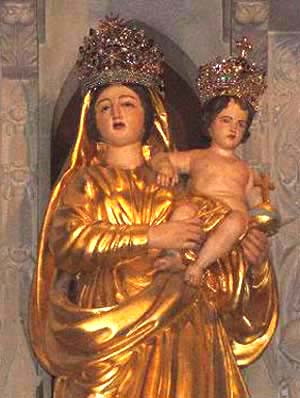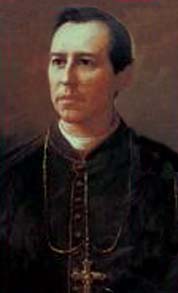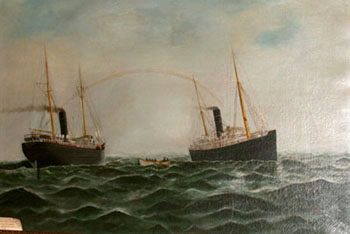 |
Stories & Legends
The Rainbow Crossing Miracle
Judith Fife Mead
The Ursuline nuns have maintained a presence in New Orleans since 1727, when a group of French Ursulines, under the reign of Louis XV, arrived there to teach the children of the colonists and to nurse the sick. My Ursuline Mothers, who taught me for 11 years, impressed upon their students the importance of history and the link between New Orleans history and devotion to Our Lady of Prompt Succor.

The crowned statues - the jewels were donated by the people of New Orleans |
I remember with fondness the celebratory feast days of St. Angela, St. Ursula, and Our Lady of Prompt Succor, when we would wear our dress uniforms – all white – and, after High Mass, spend the day learning about the many ties between the Ursulines and the city of New Orleans.
We would sometimes be given the opportunity to venerate the “Sweetheart Statue,” a small statue of Our Lady of Prompt Succor, which in 1812 was placed on a window sill facing the fire which was ravaging the city and threatening the Convent. After the nuns begged Our Lady to save them, the wind changed direction, and the Convent was spared. This statue, now in the Chapel, was formerly in the cloister and was brought out for the pupils to venerate only on special occasions.
I remember being shown the hand-written letter from President Andrew Jackson, assuring the nuns of their safety and property rights when Louisiana changed hands. I still have in my memory the vivid image of the exquisitely embroidered vestments worn by chaplains and Bishops in the annual Masses commemorating the 1815 victory of the Battle of New Orleans.
I was amazed at seeing what I called “The Rainbow Painting” and hearing the miraculous story that it depicts. The painting, a picture of two ships at sea linked by a rainbow in the sky behind them, is a memorial to a miracle at sea worked by Our Lady of Prompt Succor for Archbishop Francis Janssens shortly after his death in 1897. The Archbishop was a tireless promoter of her cause, and, as you will see, Our Lady came to his prompt succor in his time of need.
First coronation in the U.S.
When the Dutch-born priest Francis Janssens became Archbishop of New Orleans in 1888, he found a large Catholic population sharply divided along ethnic and racial lines. Seeking a unifying symbol for the often-antagonistic French Creoles, Irish, Italians, Germans and Negroes, he found it in devotion to Our Lady of Prompt Succor.

Archbishop Francis Janssens (1843-1897) of New Orleans |
The Archbishop prayed to Our Lady of Prompt Succor for this end: “I am going to offer up to her the heart of everyone here, everyone in the State of Louisiana, that she may preserve us all from sin and protect us also in our temporal interests and be a mother to us, each and everyone, every day of our lives, and finally at the moment when we lie upon our deathbeds.” Largely through his efforts, Our Lady of Prompt Succor became the patroness of New Orleans and all Louisiana.
On a visit to Rome in June 1894, after giving the Pope a picture of the statue and a list of miracles attributed to her, Archbishop Janssens requested that this statue be crowned. Four days later, approval for a papal coronation was given. Two papal decrees arrived at New Orleans soon afterward. In one, the Pope granted special indulgences for the Confraternity of Our Lady of Prompt Succor, newly founded by the Archbishop to promote the devotion throughout the Archdiocese. The second announced the coronation of the miraculous statue – the first papal crowning of the Virgin Mary in the United States.
The coronation took place on November 10, 1895, at the Ursuline Academy Convent Chapel. Five Bishops, many clergy and thousands of the faithful – many standing outdoors in the pouring rain and cold – were present to honor Our Lady under this title. The ladies of New Orleans had donated their jewels for the making of the magnificent gold crowns, one for Our Lady and the other for the Child Jesus she carries in her arms.
The miracle at sea
The Ursulines had not attributed any major miracle to Our Lady of Prompt Succor since the 1815 victory over the British in the Battle of New Orleans, after which General Andrew Jackson himself came to the Convent to thank the nuns for their prayers and to acknowledge the role of divine intervention in his triumph. Certain that the newly crowned Virgin wanted to become better known in her city, the Archbishop encouraged the faithful to pray to her for miracles. Her response was prompt. Before the end of the 19th century, two important miracles were added to the Archdiocesan records.

The Rainbow Crossing |
The first was on behalf of Bishop Theophile Meerschaert of the Oklahoma Territory, one of the Prelates who had presided at the crowning. One month after the crowning, doctors diagnosed the Bishop with Bright’s disease and gave him one week to live. Hearing that diagnosis, he immediately left for New Orleans to solicit the help of Our Lady of Prompt Succor, and the Ursulines started a novena for his rapid recovery.
On the 5th day of the novena his condition had changed, and he was on his way to recovery. The doctors and priests affirmed that there was no doubt that his cure was “absolutely miraculous.”
The second miracle, illustrated in the ‘Rainbow Crossing,’ involved Archbishop Janssens. On June 9, 1897, he set sail on the Creole for the Netherlands and France to raise funds for the Archdiocese. He died unexpectedly of a heart attack during the first night of the voyage.
The Chancellor of the Archdiocese implored the Captain to return the body of the Archbishop to New Orleans, but he refused. The Archbishop would have to be buried at sea, that is, his body would be wrapped in cloth and dumped into the ocean waters.
That night, the passengers aboard prayed to Our Lady of Prompt Succor, asking her to provide a way to return in order to bury Archbishop Janssens in a proper Church ceremony. The next morning a ship sailing for New Orleans, The Hudson, passed the outgoing vessel. A rainbow appeared in the sky as the transferral of the Archbishop’s body began, and it was completed under the arch of that rainbow.
The people of New Orleans considered this “miracle at sea” evidence of Our Lady of Prompt Succor’s capacity for hasty intercession.
Shortly after the incident, a picture was painted titled “The Transferral of an Archbishop at Sea” to commemorate the providential appearance of The Hudson. In 1898 Sister Ste. Helene Forstall, an Ursuline at the Academy, painted a copy of that picture, and her painting is the one you can see to this day at the entrance of the Ursuline Museum in the Academy on State Street in New Orleans.
Material for this article was taken from Saints and Their Cults in the Atlantic World by Margaret Jean Cormack (Un. of South Carolina Press, 2007). My thanks also to Mary Lee Harris, Director of Development at Ursuline Academy, for providing a picture of the painting and additional information about it, and to Sylvia Probst, Ursuline’s archivist, for her assistance.

Posted July 26, 2010


Related Topics of Interest
 Our Lady of Prompt Succor, a Patroness
for Americans Our Lady of Prompt Succor, a Patroness
for Americans
 La Conquistadora - Our Country's Oldest Madonna La Conquistadora - Our Country's Oldest Madonna
 Tears, a Miraculous Warning Tears, a Miraculous Warning
 The Chastisement of Katrina The Chastisement of Katrina
 Slideshow
of Our Lady of Guadalupe Slideshow
of Our Lady of Guadalupe
 Annual Procession of The Virgin of the Dew Annual Procession of The Virgin of the Dew
 Our Lady of the Miracle Our Lady of the Miracle
 The Final Words of the Salve Regina The Final Words of the Salve Regina
 Our Lady of the Rosary Our Lady of the Rosary

Related Works of Interest
|
|
Legends | Religious |
Home | Books | CDs | Search | Contact Us | Donate

© 2002-
Tradition in Action, Inc. All Rights Reserved
|
 |
|